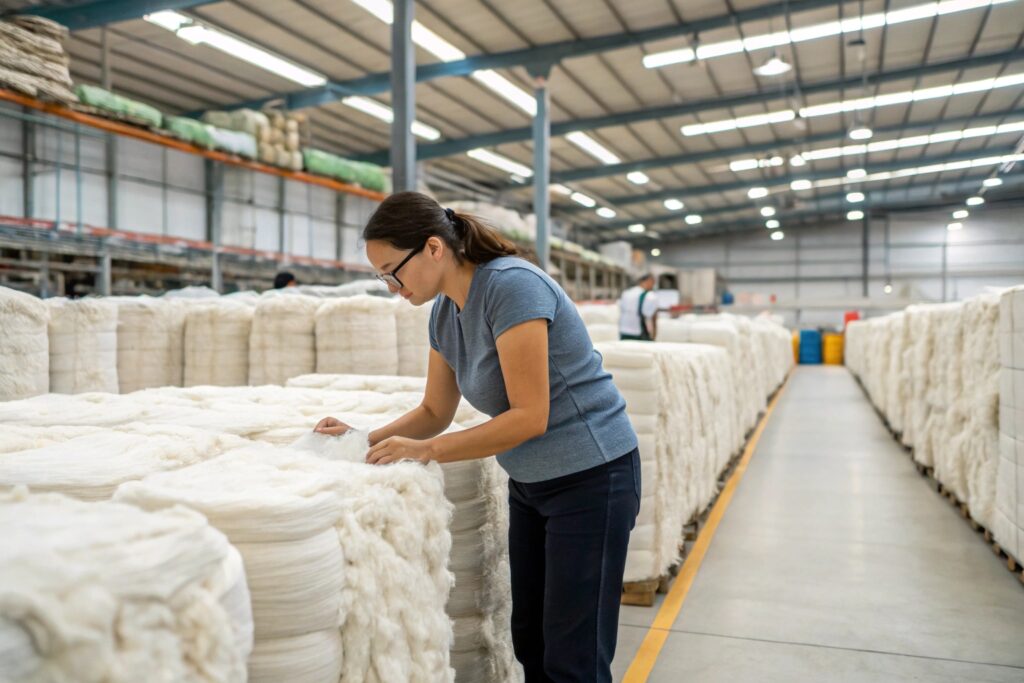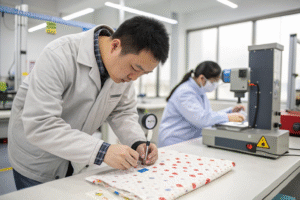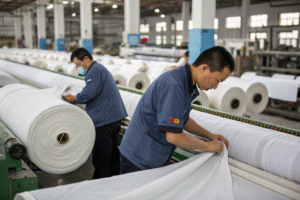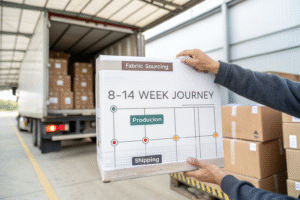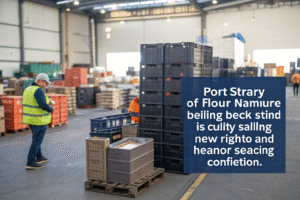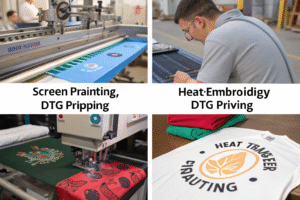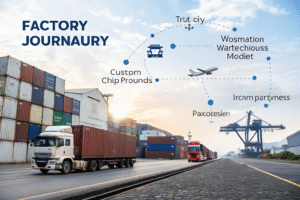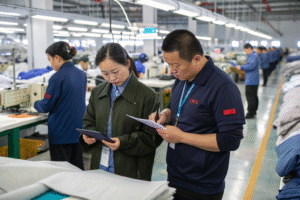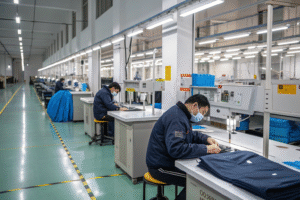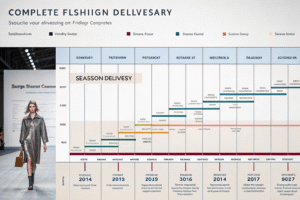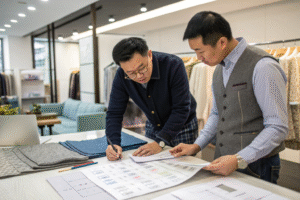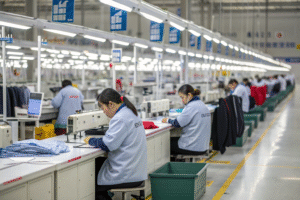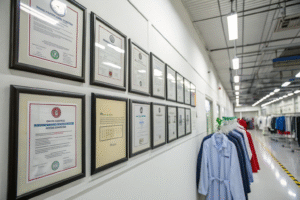Garment manufacturing is a long and intricate process that transforms raw materials into finished apparel. But how does clothing go from fiber to retail shelves?
Garment production follows a structured journey from sourcing raw materials and fabric production to design, assembly, quality control, branding, and distribution. Every step ensures quality, efficiency, and market readiness.
Understanding this process helps brands optimize production, reduce waste, and meet customer expectations.
Sourcing Raw Materials and Fabric Production
The journey of a garment begins with raw materials. But how are fabrics sourced and produced?
Fabric production starts with selecting raw materials like cotton, polyester, or wool, followed by spinning, weaving, dyeing, and finishing. High-quality fabrics ensure durability and comfort in finished garments.
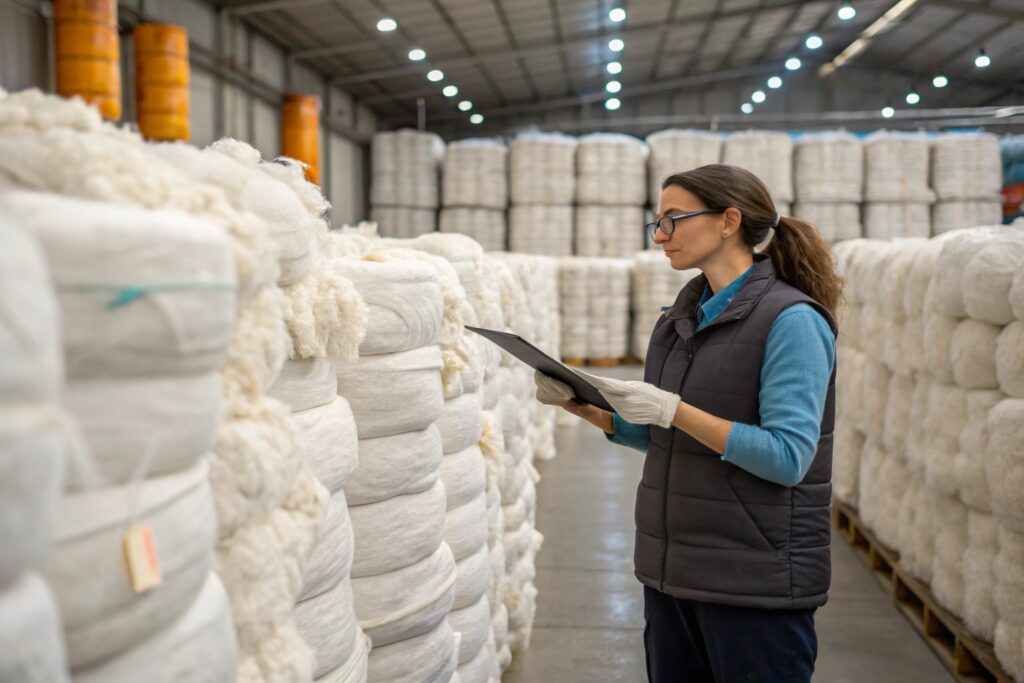
What are the key steps in fabric production?
| Step | Description |
|---|---|
| Raw Material Sourcing | Cotton, silk, wool, and synthetic fibers are collected |
| Fiber Processing & Spinning | Fibers are spun into yarns |
| Weaving or Knitting | Yarns are turned into fabric sheets |
| Dyeing & Printing | Colors and patterns are applied to fabrics |
| Finishing | Fabrics are softened, waterproofed, or textured |
How does fabric choice impact garment quality?
- Natural fibers (cotton, linen) offer breathability.
- Synthetic fibers (polyester, nylon) provide durability and elasticity.
- Blended fabrics combine benefits, balancing performance and cost.
Design, Pattern Making, and Prototyping
After fabric production, the next phase is transforming ideas into wearable designs. But what does this process involve?
Designers create sketches, develop patterns, and produce prototypes to test garment fit and quality. Precision in this stage ensures efficiency in mass production.

What are the critical steps in fashion design?
| Step | Purpose |
|---|---|
| Concept Development | Defines garment aesthetics and function |
| Sketching & CAD Design | Creates digital and hand-drawn visuals |
| Pattern Making | Develops technical garment templates |
| Prototyping & Fitting | Produces sample pieces for testing |
Why is pattern making essential in garment production?
Patterns act as blueprints, ensuring that each garment is cut and assembled accurately, reducing fabric waste and production errors.
Manufacturing, Quality Control, and Assembly
Once designs and prototypes are approved, large-scale production begins. But how are garments mass-produced while maintaining quality?
Garment manufacturing involves fabric cutting, sewing, assembly, finishing, and quality control. Strict monitoring at each stage ensures consistency in production.

What are the major steps in garment manufacturing?
| Step | Function |
|---|---|
| Fabric Cutting | Precision cutting using manual or automated tools |
| Sewing & Stitching | Assembling fabric pieces into garments |
| Finishing & Trims | Adding zippers, buttons, labels, and embellishments |
| Ironing & Pressing | Smoothing fabric for a polished look |
| Final Quality Inspection | Checking for defects before packaging |
How do manufacturers ensure quality control?
- Automated cutting machines reduce human errors.
- In-line inspections detect stitching and fit issues early.
- AI-powered quality checks improve defect detection.
Branding, Packaging, and Retail Distribution
A finished garment is not ready for sale without branding and packaging. But how does the product reach consumers?
Garments go through branding, packaging, and distribution before they arrive in retail stores or online marketplaces. These steps shape brand perception and customer experience.

What are the key elements of branding and packaging?
| Component | Role in Marketing |
|---|---|
| Brand Labels & Tags | Reinforce brand identity |
| Eco-Friendly Packaging | Attracts sustainability-conscious consumers |
| Custom Packaging Designs | Enhances customer unboxing experience |
| Retail-Ready Folding & Bagging | Ensures garments arrive in pristine condition |
How do brands distribute garments to customers?
- Wholesale distribution supplies retailers and department stores.
- E-commerce platforms sell directly to consumers worldwide.
- Private label partnerships allow brands to manufacture for other labels.
Conclusion
The garment manufacturing process—from sourcing raw materials to branding and retail distribution—is a carefully coordinated journey. Each step contributes to product quality, sustainability, and market success. By optimizing these processes, fashion brands can improve efficiency, reduce waste, and create garments that align with consumer expectations.

